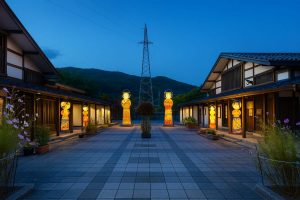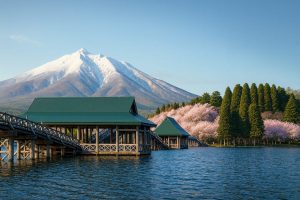| Population | 4,671 people |
|---|---|
| Area | 230.3 km² |
| Population Density | 20.28 people/km² |
Located at the northernmost tip of Japan, Sotogahama Town in Aomori Prefecture has a history and culture that dates back to the Nara period when it was first developed. During the Showa era, fishing became a thriving industry, and this tradition continues today, with a food culture rich in seafood that colors the town. Additionally, the production of apples, a major industry, boasts one of the largest scales in Japan, and every autumn, an apple festival is held, bringing vibrancy to the town. Life in Sotogahama Town is rich in nature, with seasonal landscapes enhancing the town’s charm. A unique food culture has emerged, utilizing its beautiful natural environment and abundant seafood. The Tsugaru dialect is commonly spoken, and many local traditional festivals are held, allowing residents to strongly feel the local culture. Furthermore, the Nebuta Festival, a close presence for locals, is a major event that attracts numerous tourists every year. In addition, Aomori Prefecture’s Sotogahama Town is filled with attractions that allow visitors to enjoy the beauty of the changing seasons. Moreover, the local people not only speak a unique dialect but also pass down ancient customs. In particular, local festivals symbolize this, with various traditional events held throughout the year, deepening community bonds. Alongside seafood, apple production is also active, and its high quality is recognized nationwide.
Culture and Customs
Sotogahama Town, whose history began with development in the Nara period and became a fishing hub during the Showa era, is a town in Aomori Prefecture. The current main industry is apple production, nurtured by moderate coolness and pure water sources, with the apple festival held in conjunction with town revitalization, making apples a symbol of the town. Fishing is also an important industry, with a food culture rooted in the blessings of the sea. The Tsugaru dialect is spoken in daily life, and its unique sound enhances the local atmosphere. Additionally, many traditional festivals are held, with the Nebuta Festival being a major event that attracts large numbers of tourists, adding color to the lives of local people. In this nature-rich area, people live in harmony with nature. They incorporate the blessings of rivers, seas, and mountains into their daily lives, experiencing the seasons as they live. Sotogahama Town is a charming place where nature, history, and culture are intertwined. Local residents enjoy dishes made with seasonal seafood, feeling the blessings of the region every day. Furthermore, the Tsugaru dialect, with its unique sound, vividly expresses the local climate.
Local Specialties
- Sotogahama Town Apples: The warm climate and abundant sunshine in this region yield apples that are sweet and juicy.
- Sotogahama Town Cherries: Known for their unique sweetness and vibrant colors, they attract many visitors during the peak season.
- Sotogahama Town Seafood: This town, facing a rich sea, is known for its fresh and delicious seafood.
- Sotogahama Town Green Onions: Grown in fertile soil, these green onions are characterized by their strong sweetness and unique aroma and texture.
- Sotogahama Town Handmade Miso: Handmade miso made from locally produced soybeans is praised for its deep flavor and aroma.
Annual Events
- “Nebuta Festival”: Held in August, this festival features giant nebuta floats parading through the town, celebrating the end of summer with traditional flute and drum sounds.
- “Sotogahama Cherry Blossom Festival”: Held every April, this festival allows visitors to enjoy the local cherry blossom spots, painting beautiful scenery with colorful blooms.
- “Snowman Festival”: Held in February during winter, this event focuses on making large snowmen, with participants showcasing their skills.
- “Beach Opening Festival”: Celebrating the arrival of summer, this festival opens local beaches, praying for enjoyment and safety along the coast.
- “Sotogahama New Year Festival”: Held at the beginning of the year, this festival celebrates the arrival of the new year and prays for success throughout the year, bustling with local residents and visitors.
Access Methods
- By Air: Direct flights are available from various locations to Aomori Airport. From the airport, you can travel to Sotogahama Town by rental car or taxi.
- By Shinkansen: It takes about 3 hours and 30 minutes from Tokyo to Aomori Station via the Hayabusa Shinkansen. From Aomori Station, take a bus to Sotogahama Town.
- By Bus: Direct buses operate from Aomori City to Sotogahama Town. Please plan your travel with ample time.
- By Car: Using the Tohoku Expressway, it takes about 1 hour from Aomori IC to reach Sotogahama Town. Traveling by car offers high flexibility and convenience.
- By Ferry: Ferries are also available from Niigata Port to Aomori Port. Many overnight ferries are convenient for resting during your journey.
Tourist Attractions
- Lake Towada – A beautiful lake where you can enjoy seasonal landscapes.
- Oirase Stream – A nature-rich walking path where you can enjoy clear streams and greenery.
- Aomori City Namioka District – A UNESCO World Heritage site with charming old buildings.
- Aomori Prefectural Museum of Art – Enjoy a variety of exhibitions centered on contemporary art.
- Nebuta House Wa Rasse – See the giant floats of the Nebuta Festival year-round.








